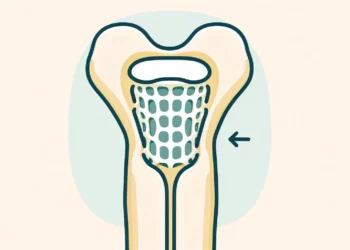
Detail of bone tissue of tibia (malleolus medialis. Credit: Wikimedia Commons.
Scientists have coaxed stem cells to transform into bone tissue in the lab. The approach mimics real early bone formation and could be used to perform custom-made treatments, as well as pave the way for the development of lab-made fully functional bones.
“Having a fully functional bone is still far away, but we are sure that it will be achieved one day,” Anat Akiva, assistant professor of Cell Biology at Radboud University in the Netherlands, told ZME Science.
Along with colleagues from the Eindhoven University of Technology, the researchers combined their expertise to form an interdisciplinary team. This proved highly useful for tackling such a big challenge as growing bone in the lab.
Bone is a very complex material and how exactly it is formed in the body is not yet fully understood. Bone is essentially a complex matrix of collagen and minerals, with a lot of blood vessels.
To make bone, three types of cells come together in unison: osteoblasts (which build bone tissue), osteoclasts (which take bone away) and osteocytes (which regulate the building and breaking down of bone).
Other research groups looking to grow bone tended to focus on only one of these types of cells. For their new study, the team from the Netherlands used stem cells to form two types of these cells (osteoblasts and osteocytes), which were ‘woven’ in a collagen matrix to form early-stage bone.
Our bone from the lab is exactly like newly formed biological bone,” Akiva said, with the research showing that the mineralized matrix is similar in structure and chemistry.
This was the culmination of four years of extensive research, during which the researchers had to overcome a number of challenges.
“When we presented this research in one of the biggest bone conferences when we just started. We, of course, were thrilled with our study, but the audience, composed of bone scientists from every field, started to question our model and whether it is not good enough because we did not show specific things they were considering important. One of them told us: come back when you show that you have osteocytes – so we did. This means that actually already in 2017 we were the first ones to show that human stem cells can differentiate into osteocytes in the lab,” Akiva said.
Both the lab-grown bone and the biological bone that it mimics produce proteins that are required for the healthy functioning of bone. This means that the lab-grown version is ideal for use as a model system of human bone which can be used to test novel therapies.
From a research perspective, being able to replicate bone at the molecular level with such accuracy may be a new milestone. Bone is made of 99% collagen and minerals, but the remaining 1% of proteins is critical for functioning bone formation.
Many bone disorders, such as brittle bone disease, have their origin at the molecular level. Having a reliable model of the human bone could thus lead to great progress in medicine.
“We are now working in several directions: we are using genomic editing to label specific proteins to know when they are produced and to follow in real-time their journey from the cells to the collagen. By that, we hope to unravel the exact function of these different proteins in bone formation,” Akiva said.
“Another topic will be to grow and follow diseased osteoblast cells (such as in brittle bone disease/osteogenesis imperfecta) to understand at the molecular level why the bones of osteogenesis imperfecta patients are so fragile.”
“And last but not least we would like to go further than only the earliest form of bone formation, so integrating other cells will also be one of the next steps we envisage.”
The findings were reported in the journal Advanced Functional Materials.






